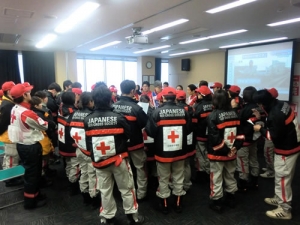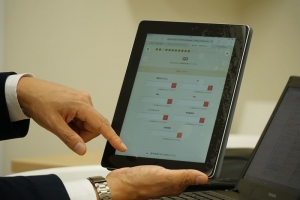Disaster Relief and Community Medicine in Tohoku (Part 2 of 3)
Part 2- Promoting Preparedness- The Importance of Disaster Education
Nicole Gunawansa | March 18th, 2015
This interview was held on January 14, 2015 in Tohoku University Hospital
Question 5: What are the current contingency plans for various types of future disasters? How have these plans been altered by 3/11?
Japan has experienced many natural disasters. Most of these disasters have been small, and thus have been forgotten by the public overtime. For this reason, prior to 3/11, most prefectures did not have reliable disaster response plans. Only a few prefectures had established contingency plans before the Great East Japan Earthquake: For example, Miyagi prefecture, Hyogo prefecture, and Niigata prefecture. The similarity among these prefectures is that they have all experienced substantially sized disasters in the past twenty years. These big disasters were far too destructive to have been quickly forgotten, and so these three prefectures established disaster medical coordinator positions and formulated basic disaster relief protocols.
Following 3/11, the Japanese government decided to have all prefectures take the same precautions that Miyagi, Hyogo, and Niigata prefecture had. Although some disaster planning has occurred throughout Japan, there is not yet a systematic plan in place for every prefecture. A lot of the disaster relief responsibility falls onto the coordinators who are trained in disaster medicine. In an attempt to ensure the best care for the Japanese people, ACT Institute of Disaster Medicine to hold training seminars for medical coordinators all over Japan. This year ACT will have twenty prefectures participating in seminars, and we hope that the number of participants continues to rise in the years to come.
Question 6: What is the ACT Institute of Disaster Medicine? What is the goal behind this organization?

Dr. Ishii conducted rescue teams after the disaster in Ishinomaki area.
In the time following 3/11, I established the Ishinomaki-Zone Joint Relief Team. This team worked in close collaboration with the Red Cross and Disaster Medical Assistance Team (DMAT). The teamwork and sharing of brainpower that these groups demonstrated inspired the creation of the ACT Institute of Disaster Medicine. ACT is a logistics non-profit organization whose objectives are: To dispatch advisory staff to the HQ of the next disaster relief team, act as a channel of communication for collaboration with enterprises, and host lecture programs for prefecture disaster medical coordinators and HQ personnel.
The ACT Institute of Disaster Medicine hopes to create a reliable relief response network by promoting human resource and cultivating medical personal. We hope to ensure that Japan has a commendable medical coordinating system so that response can be more resourcefully when the time comes.
Question 7: Can you please discuss the Medical Doctor Education Grant and your reasons for promoting increase local outreach by general practitioners (GPs)?
With the funding from this grant, Tohoku University Hospital educates GPs and other local hospital personal about general and disaster medicine. Seminars are held once every two weeks in local hospitals. We use MMWINTM (Miyagi Medical and Welfare Information Network) and ICT (information and communication technology) to engage these medical professionals in teleconferences with our lecturers including an invited professors from Teikyo University. The invited professors are specialist trained to teach local general practitioners about clinical research and other novel medical techniques. General practitioners are the focus of this education grant because only a few doctors (who are often not medical specialists) are available in local areas. These doctors have to see every kind of patient, and so training GPs is a primary focus in local environments in order to promote optimal medical support.
Question 8: Please discuss the mobile application designed to assess evacuation shelters in future disaster situations? How does it work and who can utilize this app?
 During the management of disaster relief in 2011, Ishinomaki Zone joint relief team conducted surveys of medical, sanitary, and environmental conditions. The process of evaluation, calculation, and analysis with manual operation using software such as Excel was associated with large, tedious workloads for staff members. To decrease this burden, we developed an assessment system that utilizes mobile devices.
During the management of disaster relief in 2011, Ishinomaki Zone joint relief team conducted surveys of medical, sanitary, and environmental conditions. The process of evaluation, calculation, and analysis with manual operation using software such as Excel was associated with large, tedious workloads for staff members. To decrease this burden, we developed an assessment system that utilizes mobile devices.
The mobile application project was funded by Miyagi prefecture to help promote faster assessment and transfer of information from evacuation centers to local governments and medical coordinating teams. This is the first project of its kind, and we are currently in the second year of a three year project. As of right now, the mobile application is web based, but we will have a downloadable version for iOS devices soon.
The application is fairly straight forward. It consists of several questions relating to the locations and conditions of the evacuation centers during the aftermath of a disaster. Dispatched relief teams assessing affected disaster areas would use this application when visiting centers. General evacuation center information, such as address and the name of the person in charge of it, is initially inputted. Then the app asks questions about the number of evacuees, the number of patients, the types of patients (type of ailments), the amount of supplies available and needed (food, water, blankets, etc.), and the condition of power sources. The questions continue on until the relief teams have sufficient information to electronically send to local headquarters. At headquarters, medical coordinators and local government officials will have an analyzable database (created by this app) about all of the assessed evacuation centers. This database will help those managing the relief efforts to make future decisions about how to proceed in the days following the disaster.
I believe that this application will be a great aid in wake of a future disaster. Ideally, I would like to see this app also being used by DMAT (and integrated into their Emergency Medical Information System) so that local, regional, and national relief teams could upload/share information about a disaster situation.
